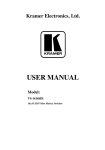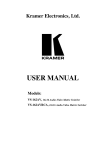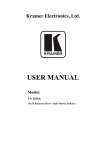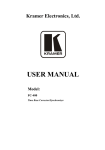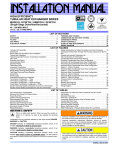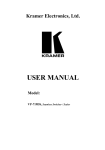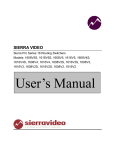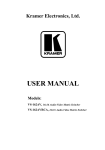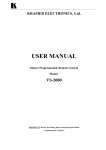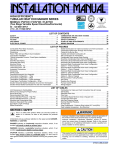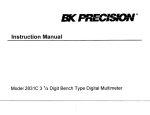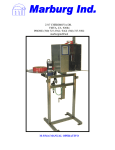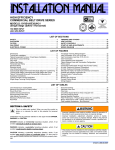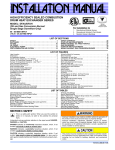Download USER MANUAL - Kramer Electronics
Transcript
Kramer Electronics, Ltd. USER MANUAL Model: VS-1616V 16x16 Video Matrix Switcher Contents Contents 1 2 3 4 5 6 6.1 Introduction Getting Started Overview Summary of how to Operate a Single Machine Your Video Matrix Switcher Installing the Video Matrix Switcher Configuring a Stand Alone Switcher 1 1 2 3 4 7 7 6.1.1 6.1.2 6.1.3 6.1.4 Configuring a single VS-1616V Unit (16x16 CV) for Composite Video Configuring a single VS-1616V Unit (8x8 Y/C Switcher) for s-Video Configuring a single VS-1616V Unit (5x5) YUV/RGB Switcher Configuring a single VS-1616V Unit (4x4) RGBS Switcher 8 8 8 9 6.2 Assembling a Multi-channel Video Switcher 6.2.1 6.2.2 6.2.3 Configuring a 16x16 Y/C Switcher (2 Units) Configuring a 16x16 YUV/RGB Switcher (3 Units) Configuring a 16x16 RGBS Switcher (4 Units) 10 10 11 6.3 Assembling an Expanded Matrix Switcher 12 6.3.1 6.3.2 Assembling a 32x16 Switcher Assembling a 32x32 Switcher 12 13 6.4 6.5 Assembling a System of Interconnected Switchers Dipswitch Settings 15 17 6.5.1 6.5.2 6.5.3 6.5.4 Setting the MACHINE # Setting the MACHINE ADDRESS # Understanding the SYSTEM Mode Understanding the SLAVE Mode 17 18 18 19 6.6 Connecting a Control Interface 19 6.6.1 Connecting the RS-232 Control Interface 20 6.6.2 6.6.1.1 6.6.1.2 6.6.1.3 6.6.1.4 6.6.1.5 6.6.1.6 Connecting 2 VS-1616V Units using a Null-modem Adapter Connecting 2 VS-1616V Units without using a Null-modem Adapter PC DB9 COM Port Connection to a VS-1616V Unit with a Null-modem Adapter PC DB9 COM Port Connection to a VS-1616V Unit with no Null-modem Adapter PC DB25 COM Port Connection to a VS-1616V Unit with a Null-modem Adapter PC DB25 COM Port Connection to a VS-1616V Unit with no Null-modem Adapter 9 21 21 21 22 22 22 Connecting the RS-485 Control Interface 23 6.7 6.8 7 7.1 7.2 Configuring the Sync Connecting the KEYBOARD EXTENSION Operating Your Video Matrix Switcher Startup Display Using the Front Panel Buttons 26 26 27 27 28 7.2.1 Confirming Settings 28 7.2.2 Switching 29 7.2.1.1 Toggling between the AT ONCE and CONFIRM Modes 29 i Contents 7.2.2.1 Switching one Input to one Output 7.2.2.2 Switching several Inputs to several Outputs 7.2.2.3 Switching one Input to all Outputs 29 30 31 7.2.3 Clearing 32 7.2.4 Storing and Recalling Setups 35 8 8.1 8.2 8.3 8.4 MENU Commands Sequence Locking and Unlocking the Front Panel Choosing the Follow-System or Breakaway-From-System Mode Choosing the Video Format Setting Setting the MACHINE ADDRESS 36 38 39 40 41 7.2.3.1 Clearing an Output 7.2.3.2 Clearing several Outputs 7.2.3.3 Clearing all Outputs 32 33 34 7.2.4.1 Storing Setups 7.2.4.2 Recalling Setups 35 35 8.4.1 Changing the MACHINE ADDRESS from stand alone to a large matrix 42 8.4.2 Changing the MACHINE ADDRESS from a large matrix to stand alone 43 8.4.3 Changing the MACHINE ADDRESS from a large matrix setting to a large matrix setting with a different MACHINE ADDRESS 44 8.5 Choosing the SWITCHING METHOD Setting 46 8.5.1 8.5.2 Understanding the SWITCHING METHOD Settings Configuring a SWITCHING METHOD 46 47 8.6 8.7 8.8 8.9 8.10 8.11 8.12 8.13 9 9.1 9.2 10 11 Choosing the extended Keyboard Setting Setting the STORE/RECALL KEYBOARD Mode Choosing what to INDICATE Choosing the COMMUNICATION Setting Setting the IR REMOTE Control Choosing the AUTO STORE Current SETUP Identifying the MACHINE Choosing the initial RESET Flash Memory Upgrade Connecting the PC to the RS-232 Port Upgrading Firmware Technical Specifications Communication Protocol 48 48 49 50 51 52 52 53 54 54 54 57 57 ii KRAMER ELECTRONICS, LTD. Contents Figures Figure 1: Dipswitch Setup on a Single Machine Figure 2: VS-1616V 16x16 Video Matrix Switcher Figure 3: Configuring the VS-1616V for Composite Video (CV) Figure 4: Configuring the VS-1616V for s-Video (Y/C) Figure 5: Configuring the VS-1616V for YUV (RGB) Figure 6: Configuring the VS-1616V for RGBS Figure 7: Configuring a 16x16 YUV (RGB) Switcher with 3 VS-1616V Switchers Figure 8: MACHINE ADDRESS # Designation Figure 9: Connecting the 32x16 Switcher Figure 10: Connecting the 32x32 Switcher Figure 11: Assembling a System of Interconnected Switchers Figure 12: Rear Panel Dipswitches Figure 13: Connecting a PC to 4 VS-1616V Units Figure 14: Connecting a PC (with a 25-pin connector) without a Null-modem Adapter Figure 15: RS-485 Connector PINOUT Figure 16: Connecting the RS-485 Connectors between 2 VS-1616V Units Figure 17: An RS-485 Control Interface Setup Figure 18: Keyboard Extension (EXT. KEYS) Connector Figure 19: Default Startup Status Display Sequence Figure 20: Sequence of MENU Commands Figure 21: Choosing the MTX (SYNC from Matrix) Setting Figure 22: Choosing what to INDICATE Figure 23: Machine Identification 3 5 8 8 9 9 11 12 13 15 16 17 20 23 23 24 25 27 28 37 47 49 53 Tables Table 1: Quick Reference Operating Guide for a Single Machine Table 2: Front Panel VS-1616V 16x16 Video Matrix Switcher Features Table 3: Rear Panel VS-1616V 16x16 Video Matrix Switcher Features Table 4: Stand Alone Switcher Configuration for CV, Y/C, YUV (RGB) and RGBS Table 5: Multi-channel VS-1616V Configuration for CV, Y/C, YUV (RGB) and RGBS Table 6: Dipswitch Definitions Table 7: Machine # Dipswitch Settings Table 8: Summary of Basic IR-1 Setups Table 9: Summary of Basic IR-1 Operations Table 10: Technical Specifications of the VS-1616V Video Matrix Switcher Table 11: Hex Table for the VS-1616V Video Matrix Switcher 4 6 6 7 10 17 18 51 51 57 58 iii ADDENDUM: VS-1616A, VS-1616AD, VS-1616SDI, VS-1616V, and VS-162V This addendum describes the ASCII protocol in the 1616 series. The ASCII protocol applies to firmware version 3.3 or higher. ASCII Protocol: General The ASCII protocol has 3 basic commands: Y for connect, T for recall, P for store. Before using the ASCII protocol, you need to select it from the machine’s front panel. Press the MENU button until you get to “set communication protocol” and then choose the ASCII protocol. This is saved in the non-volatile memory, so the machine will remain as ASCII even after cycling power. To check that the protocol has been selected, and to confirm that the communication is OK, send the string **!! to the VS-1616A. It should reply by sending the string OK!! ASCII Protocol: Description The 3 basic commands are Y, T, and P. “Y” command: MAKE A CROSSPOINT CONNECTION. The format is: ** Y o#, i# !! where i# is the input number, and o# is the output number. Note: The string does not need a space (spaces are used here just to add clarity to the explanation). For example: **Y3,4!! would connect input 4 to output 3 **Y9,6!! would connect input 6 to output 9 **Y2,17,Y43,12,Y7,6!! would connect input 17 to output 2, input 12 to output 43, and input 6 to output 7. The buffer allows up to 63 characters. Thus you could place up to about 10 crosspoint connections in a single string. Also: **Y0,5!! would connect input 5 to all outputs **Y3,0!! would disconnect output 3 “T” command: RECALL A SETUP. The format is: ** T s# !! where s# is the setup number (1 to 99) which is to be recalled. For example: **T13!! would recall setup number 13 “P” command: STORE A SETUP. The format is: ** P s# !! where s# is the setup number (up to 99) where the machine’s present status is to be stored. For example: **P13!! would store in setup number 13 The reply for all commands could be: OK!! or ERROR!! P/N: 2900-0020531 A1 Introduction 1 Introduction Dedication by Kramer Electronics since 1981, to the development and manufacture of high quality video/audio equipment, makes the Kramer line an integral part of the finest production and presentation facilities in the world. In recent years, Kramer has redesigned and upgraded most of the line, making the best even better! The Kramer line of professional video/audio electronics is one of the most versatile and complete available, and is a true leader in terms of quality, workmanship, price/performance ratio and innovation. In addition to our high quality switchers and matrices, we also offer excellent distribution amplifiers, remote controllers, processors, interfaces and computer-related products. Congratulations on purchasing your Kramer VS-1616V 16x16 Video Matrix Switcher. This product is ideal for the following typical applications: Professional display systems requiring video signal routing Broadcast, presentation and production facilities Rental/staging applications Monitoring in large duplication systems The package includes the following items: VS-1616V 16x16 Video Matrix Switcher Power cord Windows 95/98/2000/NT TM Kramer control software Null-modem adapter This user manual1 Kramer concise product catalog/CD 2 Getting Started We recommend that you: Unpack the equipment carefully and save the original box and packaging materials for possible future shipment Review the contents of this user manual 1 Download up-to-date Kramer user manuals from the Internet at this URL: http://www.kramerelectronics.com/manuals.html 1 Overview 3 Overview The Kramer VS-1616V is a high performance 16x16 vertical interval matrix switcher for composite video signals on BNC connectors. In addition to its typical 16x16 operation, the VS-1616V can be configured as follows: 8x8 for s-Video (Y/C) 5x5 for YUV or RGB (with the sync on the Green signal - RGsB) 4x4 for RGBS signals A main advantage of the VS-1616V is that it forms part of the series of 16x16 matrix switchers that includes, but is not limited to, VS-1616A (a 16x16 analog balanced stereo audio matrix switcher), VS-1616VD (a 16x16 digital video matrix switcher), VS-1616AD (a 16x16 digital audio matrix switcher), and VS-1616RS (an RS-422 control signal matrix switcher). In particular, the VS-1616V: Produces glitch-free transitions, when sources share a common reference sync1 Offers excellent video performance, which ensures that it remains transparent in almost any video application In addition the VS-1616V: May be used as a single unit, or expanded to up to 96 x 96 inputs/outputs Can be configured into a Kramer multi-signal switcher system including digital and analog video, digital and analog audio, and RS-422 control switchers When integrated in a system, all units switch in true audio-follow-video mode Recalls up to 15 (or more2) configuration setups via the non-volatile memory and provides for an unlimited quantity of setups when using the Kramer control software on your PC Includes a user-friendly LCD display (making operation even easier) With its FLASH memory, lets you upgrade to the latest Kramer firmware version via Internet download Comes with a choice of protocol format: hexadecimal or ASCII 1 As it switches during the vertical interval 2 Depending on the firmware version 2 KRAMER ELECTRONICS, LTD. Summary of how to Operate a Single Machine Control the VS-1616V: Using the front panel buttons Remotely, by RS-485 or RS-232 serial commands transmitted by a touch screen system, PC, or other serial controller Remotely, from the Kramer IR-1 Infra-Red Remote Control Transmitter Via external dry-contact push buttons To achieve the best performance: Connect only good quality connection cables, thus avoiding interference, deterioration in signal quality due to poor matching, and elevated noise levels (often associated with low quality cables) Avoid interference from neighboring electrical appliances that may adversely influence signal quality and position your Kramer VS-1616V in a location free from moisture and away from excessive sunlight and dust 4 Summary of how to Operate a Single Machine By default, the VS-1616V is setup for use as a single machine. This means that it is: A 16x16 composite video switcher Switched during the vertical interval of the external reference In particular, be sure that the dipswitches are set as Figure 1 illustrates (see section 6.5 for further details): Figure 1: Dipswitch Setup on a Single Machine To operate a single machine, see Table 1. 3 Your Video Matrix Switcher Table 1: Quick Reference Operating Guide for a Single Machine 5 To perform this command: Press: Connect an input with an output OUT #; IN # Reset a specific output OUT #; OFF Reset all outputs Connect all outputs to a specific input ALL; OFF ALL; IN # Store a setup STO; OUT #; TAKE Recall a setup RCL; OUT #; TAKE Lock front panel MENU; TAKE Unlock front panel TAKE; TAKE Change default setup Press the Menu button several times until you reach the appropriate Menu setup command and follow the instructions Your Video Matrix Switcher Figure 2 illustrates the front and rear panels of the VS-1616V. Tables 1 and 2 define the front and rear panels of the VS-1616V, respectively. 4 KRAMER ELECTRONICS, LTD. Figure 2: VS-1616V 16x16 Video Matrix Switcher Your Video Matrix Switcher 5 Your Video Matrix Switcher Table 2: Front Panel VS-1616V 16x16 Video Matrix Switcher Features # Feature Function 1 IR Receiver 2 3 4 Power Switch ALL Button OFF Button 5 6 7 8 9 IN Buttons OUT Buttons STO Button RCL Button LCD MATRIX 1 Display LCD STATUS 1 Display MENU Button TAKE LED TAKE Button The red LED is illuminated when receiving signals from the Kramer Infra-red remote control transmitter Illuminated switch supplying power to the unit Pressing ALL followed by an INPUT button, connects that input to all outputs An OFF-OUT combination disconnects that output from the inputs; an OFF-ALL combination disconnects all the outputs Select the input to switch to the output Select the output to which the input is switched Stores the current setting in the non-volatile memory Recalls a setup from the non-volatile memory Displays the selected input(s) switched to the output(s) (above or below the corresponding OUTPUT label) and user interface messages Displays the matrix status 10 11 12 13 Selects the programming commands to setup the switcher Shows the current TAKE button mode aiding the completion of actions Used to confirm and complete setup and switching Table 3: Rear Panel VS-1616V 16x16 Video Matrix Switcher Features Feature IN BNC Connector LOOP BNC Connector TERM SYNC Button 4 EXT. (extension) KEYS Terminal Block Connectors RS-485 Detachable Terminal Block Port RS-232 IN DB 9F Port RS-232 OUT DB 9M Port 5 6 7 SYNC # 1 2 3 8 SETUP Dipswitches 9 Power Connector with Fuse 10 TERM IN Buttons 11 IN BNC Connectors 12 OUT BNC Connectors Function Connects to the external video sync source Connects to the SYNC IN connector on the next unit Press to terminate at 75 or release for looping Connects to an external keyboard (remote unit) 2 Pins # 1 and # 2 are for vertical sync and Ground connection, and Pins # 3 and # 4 are for RS 485 Connects to the PC or the Remote Controller3 Connects to the RS-232 IN DB 9F port of the next unit in the daisychain connection Dipswitches for setup of the unit AC connector enabling power supply to the unit Press to terminate at 75 or release for looping4 Connect to the video sources Connect to the video acceptors 1 In sections 7.2.4 and 8, the word “Displays” refers to the LCD MATRIX and STATUS Displays 2 Push in to terminate the sync line. Push out when the sync line extends to another unit 3 If the unit is not the first unit in the line, connects to the RS-232 OUT DB 9F port of the previous unit in the line 4 Push in to terminate the input. Push out when the input extends to another unit (the last unit in the chain must be terminated when looping) 6 KRAMER ELECTRONICS, LTD. Installing the Video Matrix Switcher 6 Installing the Video Matrix Switcher To install the VS-1616V, connect the following1 to the rear panel, as required: Power cord Video input and output cables Control Interface cables between switcher units, or PC (or other controller), as section 6.6 describes Set the dipswitches, as section 6.5 describes Set the system variables using the MENU function, as section 8 describes Using the VS-1616V unit and/or other 16x16 matrix switchers in the series2, you can assemble the following kinds of systems: A stand alone switcher (see section 6.1) A multi-channel video switcher (see section 6.2) An expanded matrix switcher (see section 6.3) A system of interconnected switchers (see section 6.4) 6.1 Configuring a Stand Alone Switcher Configure your VS-1616V unit as a stand alone switcher for: Composite video (CV) (see section 6.1.1) s-Video (Y/C) (see section 6.1.2) YUV (RGB) (see section 6.1.3) RGBS (see section 6.1.4) Table 4 defines the number of inputs and outputs for each signal configuration: Table 4: Stand Alone Switcher Configuration for CV, Y/C, YUV (RGB) and RGBS Configuration Number of Inputs and Outputs on a Stand Alone Unit Composite 16x16 s-Video (Y/C) 8x8 YUV / RGB 5x5 RGBS 4x4 1 Switch OFF the power on each device before connecting it to your VS-1616V 2 Including the VS-1616A (a 16x16 analog balanced stereo audio matrix switcher), the VS-1616VD (a 16x16 digital video matrix switcher), the VS-1616AD (a 16x16 digital audio matrix switcher), and the VS-1616RS (an RS-422 control signal matrix switcher) 7 Installing the Video Matrix Switcher 6.1.1 Configuring a single VS-1616V Unit (16x16 CV) for Composite Video By default, a single VS-1616V unit is configured for composite video with 16 inputs and 16 outputs, as Figure 3 illustrates: Figure 3: Configuring the VS-1616V for Composite Video (CV) 6.1.2 Configuring a single VS-1616V Unit (8x8 Y/C Switcher) for s-Video Configure a single VS-1616V switcher as an 8x8 video matrix switcher (with 8 inputs and 8 outputs) for s-Video (Y/C) by grouping the inputs and outputs into pairs, as Figure 4 illustrates: Figure 4: Configuring the VS-1616V for s-Video (Y/C) 6.1.3 Configuring a single VS-1616V Unit (5x5) YUV/RGB Switcher Configure a single VS-1616V switcher as a 5x5 video matrix switcher for YUV (or RGB) by grouping the inputs and outputs1 into sets of 3, as Figure 5 1 Input 16 and output 16 are not used 8 KRAMER ELECTRONICS, LTD. Installing the Video Matrix Switcher illustrates. The YUV channel is also appropriate for RGsB. In this case, connect Gs for Y, R for V and B for U. Figure 5: Configuring the VS-1616V for YUV (RGB) 6.1.4 Configuring a single VS-1616V Unit (4x4) RGBS Switcher Configure a single VS-1616V switcher as a 4x4 video matrix switcher for RGBS by grouping the inputs and outputs into sets of 4, as Figure 6 illustrates: Figure 6: Configuring the VS-1616V for RGBS 6.2 Assembling a Multi-channel Video Switcher Configure VS-1616V units as a 16x16 multi-channel video switcher for: s-Video (Y/C) (see section 6.2.1) YUV (RGB) (see section 6.2.2) RGBS (see section 6.2.3) Use several VS-1616V units to expand the system, as Table 5 defines. For example, for composite configuration a single VS-1616V unit provides 16 9 Installing the Video Matrix Switcher inputs and 16 outputs. However, for s-Video (Y/C) configuration you need 2 VS-1616V units to provide 16 inputs and 16 outputs. In a multi-channel video switcher configuration, only one unit is the Master (with DIP 6 OFF). The other units are Slaves (with DIP 6 ON). The front panel of each Slave unit is always locked and the MATRIX and STATUS LCD Displays do not illuminate. The Slave units follow the Master. The Master unit operates in the regular way1, leading the Slaves in the background. To activate a multi-channel video switcher so that each unit is in the same state from the outset, do not turn on the power on the Slave units after the Master unit. Table 5: Multi-channel VS-1616V Configuration for CV, Y/C, YUV (RGB) and RGBS Configuration Number of VS-1616V Units required to make up a 16x16 Switcher 6.2.1 Composite 1 s-Video (Y/C) 2 YUV / RGB 3 RGBS 4 Configuring a 16x16 Y/C Switcher (2 Units) Configure a 16x16 video matrix switcher for s-Video (Y/C) by combining 2 VS-1616V switchers. Connect as in Figure 7, substituting the C unit for the U unit and ignoring the V unit. Set the dipswitches as Figure 7 illustrates. Connect the communication line via the RS-232 or RS-485 control interface as section 6.6 describes. 6.2.2 Configuring a 16x16 YUV/RGB Switcher (3 Units) Configure a 16x16 video matrix switcher for YUV by combining2 3 VS-1616V switchers, as Figure 7 illustrates: 1 The front panel is not locked and the MATRIX and STATUS LCD Displays illuminate 2 For a description of how to connect the RS-485 connectors between the VS-1616V switchers, refer to section 6.6.2 10 KRAMER ELECTRONICS, LTD. Installing the Video Matrix Switcher Figure 7: Configuring a 16x16 YUV (RGB) Switcher with 3 VS-1616V Switchers 6.2.3 Configuring a 16x16 RGBS Switcher (4 Units) Configure 4 VS-1616V switchers as a 16x16 video matrix switcher for RGBS, in a similar way to how Figure 7 in section 6.2.2 illustrates combining 3 VS-1616V switchers for YUV (RGB). 11 Installing the Video Matrix Switcher 6.3 Assembling an Expanded Matrix Switcher You can expand the number of inputs and outputs using several VS-1616V units1. Set the MACHINE ADDRESS # (see section 6.5.2) on each VS-1616V unit to define which inputs and outputs are configured to that particular unit when expanding, as the chart in Figure 8 illustrates. For example, to connect a 48x64 switcher (48 inputs and 64 outputs), you would configure using MACHINE ADDRESS # 1, 2, 3, 4; 7, 8, 9, 10; 13, 14, 15 and 16. You can only choose a rectangular2 configuration from the chart in Figure 8. Figure 8: MACHINE ADDRESS # Designation 6.3.1 Assembling a 32x16 Switcher As can be seen in Figure 8, a 32x16 switcher consists of 2 VS-1616V units (MACHINE ADDRESS # 1 and MACHINE ADDRESS # 7). To assemble, as Figure 9 illustrates: 1. Set the same MACHINE #3 (see section 6.5.1) on both VS-1616V units. 1 For example, a 32x32 switcher and a 32x16 switcher. In fact, you can connect up to 36 units to form a switcher with 96 inputs and 96 outputs 2 For example, like this: but not like this: 3 For a single group, this is usually set to # 1, as in the example in Figure 9 12 KRAMER ELECTRONICS, LTD. Installing the Video Matrix Switcher 2. Set the MACHINE ADDRESS # on one VS-1616V unit to 1 and on the other VS-1616V unit to 7 (refer to Figure 8). 3. Set DIP 6 OFF on both VS-1616V units. 4. Using T-connectors, connect OUTPUTS 1 to 16 on both VS-1616V units. OUTPUTS 1 to 16 become the SYSTEM OUTPUTS 1 to 16, while the inputs on the MACHINE ADDRESS # 1 are system inputs 1 to 16, and the inputs on the MACHINE ADDRESS # 7 are system inputs 17 to 32. The 2 VS-1616V units form a 32x16 switcher. Figure 9: Connecting the 32x16 Switcher 6.3.2 Assembling a 32x32 Switcher As can be seen in Figure 8, a 32x32 switcher consists of 4 VS-1616V units (MACHINE ADDRESS # 1, MACHINE ADDRESS # 2, MACHINE ADDRESS # 7 and MACHINE ADDRESS # 8). To assemble, as Figure 10 illustrates: 1. Set the same MACHINE #1 on all the 4 VS-1616V units. 2. Set the MACHINE ADDRESS # to 1, 2, 7 and 8 on each of the 4 units, respectively (refer to Figure 8). 1 Set to # 1 in most cases. In the example in Figure 10, the MACHINE # is set to # 2 13 Installing the Video Matrix Switcher 3. Set DIP 6 OFF on each of the 4 VS-1616V units. 4. Using T-connectors, connect INPUTS 1 to 16 on the VS-1616V unit designated as MACHINE ADDRESS # 2 with INPUTS 1 to 16 on the VS-1616V unit designated as MACHINE ADDRESS # 1. Terminate the INPUTS on MACHINE ADDRESS # 2 to 75 (push in the TERM button1 next to the INPUT BNCs) and put the inputs in MACHINE ADDRESS # 1 into Hi-Z state (release the TERM buttons next to the INPUT BNCs). INPUTS 1 to 16 become the SYSTEM INPUTS 1 to 16. 5. Using T-connectors, connect INPUTS 17 to 32 on the VS-1616V unit designated as MACHINE ADDRESS # 8 with INPUTS 17 to 32 on the VS-1616V unit designated as MACHINE ADDRESS # 7. Terminate the INPUTS on MACHINE ADDRESS # 8 to 75 (push in the TERM button next to the INPUT BNCs) and put the inputs in MACHINE ADDRESS # 7 into Hi-Z state (release the TERM buttons next to the INPUT BNCs). INPUTS 17 to 32 become the SYSTEM INPUTS 17 to 32. 6. Using T-connectors, connect OUTPUTS 1 to 16 on the VS-1616V unit designated as MACHINE ADDRESS # 7 with OUTPUTS 1 to 16 on the VS-1616V unit designated as MACHINE ADDRESS # 1. OUTPUTS 1 to 16 become the SYSTEM OUTPUTS 1 to 16. 7. Using T-connectors, connect OUTPUTS 17 to 32 on the VS-1616V unit designated as MACHINE ADDRESS # 8 with OUTPUTS 17 to 32 on the VS-1616V unit designated as MACHINE ADDRESS # 2. OUTPUTS 17 to 32 become the SYSTEM OUTPUTS 17 to 32. The 4 VS-1616V units form a 32x32 switcher. 1 Item 10 on the rear panel in Figure 2 14 KRAMER ELECTRONICS, LTD. Installing the Video Matrix Switcher Figure 10: Connecting the 32x32 Switcher 6.4 Assembling a System of Interconnected Switchers A major advantage of the VS-1616V is that it belongs to the series of 16x16 matrix switchers and, as such, can interconnect with other switchers in the series. This series includes, but is not limited to, VS-1616A (a 16x16 analog balanced stereo audio matrix switcher), VS-1616VD (a 16x16 digital video matrix switcher), VS-1616AD (a 16x16 digital audio matrix switcher), and VS-1616RS (an RS-422 control signal matrix switcher). The block diagram in Figure 11 illustrates how to assemble an interconnected varied-format 16x16 series switcher that consists of a 32x32 composite video matrix switcher, a 32x16 digital video matrix switcher, a 32x32 balanced stereo audio matrix switcher, and a 16x16 digital audio matrix switcher. Note that each group of switchers has a unique MACHINE # that is shared by all members of the group. In Figure 11, the 32x32 composite video matrix switcher is MACHINE # 1, the 32x16 digital video matrix switcher is MACHINE # 2 and so on. Control of the system is via the MACHINE #’s. 15 Installing the Video Matrix Switcher Figure 11: Assembling a System of Interconnected Switchers Refer to section 6.5 for details of how to set the dipswitches, and to section 6.6 for details of how to control this group of interconnected varied-format 16x16 series switchers, and other configurations. 16 KRAMER ELECTRONICS, LTD. Installing the Video Matrix Switcher 6.5 Dipswitch Settings Configure the VS-1616V by setting the 8 dipswitches as Figure 12 and Table 6 define: Figure 12: Rear Panel Dipswitches Table 6: Dipswitch Definitions Dipswitch # 1-4 5 6 7 8 6.5.1 Function: Set the MACHINE # (see Table 7 in section 6.5.1) Enables (ON) or disables (OFF) the Follow-SYSTEM mode Enables (ON) or disables (OFF) the SLAVE mode in a multi-channel configuration Disables use of a null modem adapter1 with RS-232 OFF = RS-232 connection via a null modem adapter ON = RS-232 connection without a null modem adapter RS-485 termination for first and last machine = ON (RS-485 line terminates with 110 ); for others = OFF (RS-485 line is open) Setting the MACHINE # To control a unit via RS-232 or RS-485, each unit has to be identified via its unique MACHINE #. In an extended matrix configuration, in addition to the MACHINE #, each unit is identified via its MACHINE ADDRESS #. Set the MACHINE #2 on a VS-1616V unit according to Table 7. A valid MACHINE # is from 1 to 15. 1 See section 6.6.1 2 When using a single unit, set the unit to MACHINE # 1 17 Installing the Video Matrix Switcher Table 7: Machine # Dipswitch Settings MACHINE # 6.5.2 DIPSWITCH 1 2 1 ON OFF OFF OFF 2 OFF ON OFF OFF 3 ON OFF OFF 4 OFF OFF ON OFF 5 ON OFF 6 OFF ON ON OFF 7 ON ON OFF 8 OFF OFF OFF ON 9 ON 10 OFF ON OFF ON 11 ON OFF ON 12 OFF OFF ON ON 13 ON ON 14 OFF ON ON ON 15 ON ON ON ON 3 OFF ON ON 4 OFF OFF ON ON OFF ON ON Setting the MACHINE ADDRESS # The MACHINE ADDRESS # is determined via the MACHINE ADDRESS Menu command, as section 8.4 describes. The MACHINE ADDRESS # defines which inputs and outputs are configured to that particular unit when expanding, as the chart in Figure 8 illustrates. A valid MACHINE ADDRESS # is from 1 to 36. 6.5.3 Understanding the SYSTEM Mode DIP 5 defines whether the VS-1616V unit communicates with other switchers via a common control line. You can set DIP 5 OFF to disable the Follow-SYSTEM mode in the following applications: Stand alone switcher applications1 A multi-channel video switcher application2 An expanded matrix switcher application3 You must set DIP 5 ON to enable the Follow-SYSTEM mode in an interconnected varied-format switcher application4 1 See section 6.1 2 See section 6.2 3 See section 6.3 4 See section 6.4 18 KRAMER ELECTRONICS, LTD. Installing the Video Matrix Switcher Refer to section 8.2 for a description of the MENU’s Follow-SYSTEM and Breakaway-from- SYSTEM modes. 6.5.4 Understanding the SLAVE Mode The SLAVE mode is only used for the multi-channel video switcher configuration1, for example, when using 3 VS-1616V units to form a YUV switcher, as Figure 7 illustrates. One unit is used as the Master, and the other 2 units are Slaves. The Slaves always follow the Master. In the example illustrated in Figure 7, the first VS-1616V unit is the Master (with DIP 6 set OFF disabling the Slave mode) and the second and third VS-1616V units are Slaves (with DIP 6 set ON enabling the Slave mode). On both Slave VS-1616V units, the MATRIX and STATUS Displays do not illuminate and the STATUS Display shows the following message: Keyboard LOCKED However, the STATUS Display on each Slave VS-1616V unit dynamically shows2 all changes made from the Master VS-1616V unit. Front panel control is via the Master VS-1616V unit, on which the front panel buttons are unlocked and both the MATRIX and STATUS Displays illuminate. 6.6 Connecting a Control Interface Connect a control interface (RS-232 or RS-485) unless operating a VS-1616V as a stand alone unit without any control device (that is, with control from the front panel or IR port, and not via a remote controller or a PC). The control interface must be identical on each switcher in the series of 16x16 matrix switchers; either RS-232 or RS-485. One control interface suffices. Do not use both RS-232 and RS-485 control interfaces in the same configuration. For example, in an interconnected varied-format 16x16 switcher application3, if the switcher that connects to the PC connects via the RS-232 control interface, each switcher must interconnect via the RS-232 control interface and not via the RS-485 control interface. Choose the RS-232 control interface, for a range of about 25 meters used for a point-to-point connection. 1 See section 6.2 2 Albeit with an LCD Display that does not illuminate 3 See section 6.4 19 Installing the Video Matrix Switcher Choose the RS-485 control interface, to operate the switcher from an extended distance of up to 1000 meters. 6.6.1 Connecting the RS-232 Control Interface Connect several switchers (from the series of 16x16 matrix switchers) and the control unit in an RS-232 daisy chain arrangement, with or without using a Null-modem adapter, as Figure 13 illustrates. The RS-232 daisy chain switcher arrangement is transparent. This lets you arrange the switchers (from the series of 16x16 matrix switchers) according to your requirements, and not according to a fixed sequence dependent on the MACHINE # and/or MACHINE ADDRESS #. Figure 13: Connecting a PC to 4 VS-1616V Units 20 KRAMER ELECTRONICS, LTD. Installing the Video Matrix Switcher You can connect any of the following: 2 VS-1616V units, using a Null-modem adapter (see section 6.6.1.1) or without using a Null-modem adapter (see section 6.6.1.2) The PC’s DB9 COM port to a VS-1616V unit with a Null-modem adapter (see section 6.6.1.3) or without a Null-modem adapter (see section 6.6.1.4) The PC’s DB25 COM port to a VS-1616V unit with a Null-modem adapter (see section 6.6.1.5) or without a Null-modem adapter (see section 6.6.1.6) 6.6.1.1 Connecting 2 VS-1616V Units using a Null-modem Adapter To connect 2 VS-1616V units, using a Null-modem adapter provided with the machine (default): 1. Connect a flat cable1 between the RS-232 OUT DB9 port on the first VS-1616V unit and the Null-modem adapter that attaches to the RS-232 IN DB9 port on the second VS-1616V unit. 2. On the second VS-1616V unit, set DIP 7 OFF (enabling Null-modem adapter use). 6.6.1.2 Connecting 2 VS-1616V Units without using a Null-modem Adapter To connect 2 VS-1616V units, without using a Null-modem adapter: 1. Connect a flat cable1 between the RS-232 OUT DB9 port on the first VS-1616V unit and the RS-232 IN DB9 port on the second VS-1616V unit. 2. On the second VS-1616V unit, set DIP 7 ON (disabling Null-modem adapter use2). 6.6.1.3 PC DB9 COM Port Connection to a VS-1616V Unit with a Null-modem Adapter To connect the PC’s DB9 COM port to a VS-1616V unit, using a Nullmodem adapter: 1. Connect a flat cable1 between the PC’s DB9 COM port and the Nullmodem adapter that attaches to the RS-232 IN DB9 port on the VS-1616V unit. 2. Set DIP 7 OFF (enabling Null-modem adapter use2) on the VS-1616V unit. 1 Straight one-to-one uncrossed connections with at least the 3 wires pins # 2, # 3 and # 5 2 See section 6.5 21 Installing the Video Matrix Switcher 6.6.1.4 PC DB9 COM Port Connection to a VS-1616V Unit with no Null-modem Adapter To connect the PC’s DB9 COM port to a VS-1616V unit, without using a Null-modem adapter: 1. Connect a flat cable1 between the PC’s DB9 COM port and the RS-232 IN DB9 port on the VS-1616V unit. 2. Set DIP 7 ON (disabling Null-modem adapter use2) on the VS-1616V unit. 6.6.1.5 PC DB25 COM Port Connection to a VS-1616V Unit with a Null-modem Adapter To connect the PC’s DB25 COM port to a VS-1616V unit, using a Nullmodem adapter: 1. Connect a flat cable1 between the PC’s DB25 COM port and the Nullmodem adapter that attaches to the RS-232 IN DB9 port on the first VS-1616V unit. 2. Set DIP 7 OFF (enabling Null-modem adapter use2) on the VS-1616V unit. 6.6.1.6 PC DB25 COM Port Connection to a VS-1616V Unit with no Null-modem Adapter To connect the PC’s DB25 COM port to a VS-1616V unit, without using a Null-modem adapter: 1. Connect the PC’s DB25 COM port to the RS-232 IN DB9 port on the VS-1616V unit, as Figure 14 illustrates: Female DB25 (From PC) PIN 20 connected to PIN 6 Connect PINS 4, 5 and 8 together 1 Straight one-to-one uncrossed connections with at least the 3 wires pins # 2, # 3 and # 5 2 See section 6.5 22 KRAMER ELECTRONICS, LTD. Installing the Video Matrix Switcher Figure 14: Connecting a PC (with a 25-pin connector) without a Null-modem Adapter 2. Set DIP 7 ON (disabling Null-modem adapter use1) on the VS-1616V unit. 6.6.2 Connecting the RS-485 Control Interface Figure 15 defines the RS-485 connector PINOUT for external RS-485 control. The RS-485 connector is also used (if required) for vertical sync: Figure 15: RS-485 Connector PINOUT To connect an RS-485 connector on one VS-1616V unit to an RS-485 connector on one or more other switchers (from the series of 16x16 matrix switchers), as Figure 16 illustrates: 1. Connect the “+” PIN on the first VS-1616V unit to the “+” PIN on the second VS-1616V unit or other unit 2. Connect the “-” PIN on the first VS-1616V unit to the “-” PIN on the second VS-1616V unit or other unit 3. If shielded cable is used for an RS-485 connection, connect the shield to the Ground PIN. For details about how to configure the vertical sync (if required), refer to section 6.7 and Figure 21 in section 8.5.1. 1 See section 6.5 23 Installing the Video Matrix Switcher Figure 16: Connecting the RS-485 Connectors between 2 VS-1616V Units Figure 17 illustrates the RS-485 line that connects: Between each VS-1616V unit To the PC via a Kramer Tools VP-43xl Interface Converter (connect the PC’s DB 9 COM port to the “RS-232 in” DB9F port on the VP-43xl. Next, connect the RS-485 port on the VP-43xl to the RS-485 ports on the VS-1616V units) 24 KRAMER ELECTRONICS, LTD. Installing the Video Matrix Switcher Figure 17: An RS-485 Control Interface Setup 25 Installing the Video Matrix Switcher 6.7 Configuring the Sync On the VS-1616V, you can select one of the following, as the sync input: EXTERNAL (“sync in” BNC connector) INPUT # 1 BNC connector MTX (Sync from Matrix) RS-485 Terminal Block connector, when using multiple machines1 Configure the sync via the SWITCHING METHOD Menu command setting2. When setting up multiple machines (for example, a 48x64 switcher) or a 16x16 YUV switcher, linking a common sync to all the machines may be necessary to facilitate simultaneous vertical interval switching. Usually, the easiest method is to choose the sync source from the first machine (for example, the Y unit in a 16x16 YUV switcher configuration, as section 6.2.2 describes) and then connect all the terminal block connectors, as Figure 7 illustrates. In this case, set the first machine to select the sync source from the external sync connector or from the INPUT # 1 connector. This sync is now available to the other machines via the RS-485 terminal block connector, as Figure 15 and Figure 16 illustrate. Select the MTX sync on the other machines that receive that sync. 6.8 Connecting the KEYBOARD EXTENSION Connecting dry contact-closure switches to the Keyboard Extension (EXT. KEYS) connector enables you to route an input to an output by remote control from a distance of up to 1000 meters. These IN and OUT keys are expandable3. Figure 18 illustrates how to connect the Keyboard Extension (EXT. KEYS): 1 Refer to section 8.5.1 2 Refer to section 8.5 3 Add an unlimited number of push buttons to the existing keys (in parallel) by attaching one end of the push button to the corresponding number and the other end to the IN or OUT 26 KRAMER ELECTRONICS, LTD. Operating Your Video Matrix Switcher Figure 18: Keyboard Extension (EXT. KEYS) Connector To use the Keyboard Extension, activate the extended KEYBOARD setting Menu command, as section 8.6 describes. 7 Operating Your Video Matrix Switcher Operate your VS-1616V via: The front panel buttons (as this section describes) RS-232 or RS-485 serial commands transmitted by a touch screen system, PC1, or other serial controller The Kramer IR-1 Infra-Red Remote Control Transmitter Dry contact-closure switches connected to the Keyboard Extension 7.1 Startup Display After switching on the power, the MATRIX and STATUS2 displays show the following screens in sequence: 1 For instructions on using Kramer Windows 95/98/NT TM Control Software, refer to the separate user manual (included on the CD-ROM in .pdf format), Kramer Control Software 2 Version 1.5 is shown in the Status Display as an example; text in the Matrix Display may vary (according to machine settings) 27 Operating Your Video Matrix Switcher Figure 19: Default Startup Status Display Sequence 7.2 Using the Front Panel Buttons You can switch (see section 7.2.2) and clear (see section 7.2.3): One input to one output Several inputs to several outputs One input to all outputs 7.2.1 Confirming Settings Choose to work in the AT ONCE mode or the CONFIRM mode: In the AT ONCE (default1) mode: Actions require no user confirmation Execution is immediate No protection is offered against changing an action in error In the CONFIRM mode2: You have an optional method to help avoid making a mistake Every action requires user confirmation Execution is delayed3 until the user confirms the action Protection is offered to prevent erroneous switching You can key-in several actions and then confirm them by pressing the TAKE button once, to simultaneously switch several monitors 1 For all actions except storing/recalling setups 2 The CONFIRM mode is the default for storing/recalling setups (see section 8.7) 3 Failure to press the TAKE button within 30 seconds to one minute (the Timeout) will abort the action 28 KRAMER ELECTRONICS, LTD. Operating Your Video Matrix Switcher 7.2.1.1 Toggling between the AT ONCE and CONFIRM Modes To toggle between the AT ONCE (default) mode and the CONFIRM mode, press the TAKE button. In CONFIRM mode: Actions require user confirmation and the TAKE LED lights. In AT ONCE mode: Actions do not require user confirmation and the TAKE LED does not light. When the TAKE LED blinks: You cannot toggle between the AT ONCE and CONFIRM modes You can execute the previous action, by pressing the TAKE button You can cancel the previous action, by pressing a non-relevant button (for example, the MENU button) 7.2.2 Switching You can switch: One input to one output (see section 7.2.2.1) Several inputs to several outputs (see section 7.2.2.2) One input to all outputs (see section 7.2.2.3) 7.2.2.1 Switching one Input to one Output Pressing an OUT-IN combination when your VS-1616V operates in the AT ONCE mode implements the switch immediately. To switch one input to one output (AT ONCE mode): 1. Press the appropriate OUT button. The MATRIX Display shows the 2 blinking digits, representing the present input number connected to that specific output1. If the present output is clear, the 2 blinking digits 00 appear in the MATRIX Display. The STATUS Display shows the message: out # x Where x is the output number 2. Press the appropriate IN button. The output switches to the input and the MATRIX Display shows the Input # instead of the blinking digits. The STATUS Display momentarily shows the message: 1 For example, pressing OUT button 9 shows the blinking digits 01 if input 1 was previously routed to OUT 9 29 Operating Your Video Matrix Switcher out # x from in # y Where x is the output number and y is the input number Pressing an OUT-IN combination when your VS-1616V operates in the CONFIRM mode (and the TAKE LED is lit), requires user confirmation. To switch one input to one output (CONFIRM mode): 1. Repeat step 1 above. 2. Press the appropriate IN button. The MATRIX Display shows the 2 blinking digits, representing the input number and the TAKE LED blinks. The STATUS Display shows1 the message: out # x from in # y Where x is the output number and y is the input number 3. Press the TAKE button to confirm the action. The output switches to the input and the TAKE LED lights. 7.2.2.2 Switching several Inputs to several Outputs In the AT ONCE mode, you need to execute each OUT-IN combination separately (see section 7.2.2.1). When switching many inputs to many outputs it is recommended to toggle to the CONFIRM mode. In the CONFIRM mode you can key-in several actions and then confirm them by pressing the TAKE button once (simultaneously switching several inputs to several outputs). To switch several inputs to several outputs in the CONFIRM mode (the TAKE LED is lit), do the following: 1. Press the appropriate OUT button. The MATRIX Display shows the 2 blinking digits, representing the previous input number for that specific output2. If the previous input is clear, the 2 blinking digits 00 appear in the MATRIX Display. The STATUS Display shows the message: out # x Where x is the output number 1 Continuously, within the limit of the timeout (approximately 30 seconds to one minute) 2 For example, pressing OUT button 9 shows the blinking digits 01 if input 1 was previously routed to OUT 9 30 KRAMER ELECTRONICS, LTD. Operating Your Video Matrix Switcher 2. Press the appropriate IN button. The MATRIX Display shows the 2 blinking digits, representing the input number and the TAKE LED blinks. The STATUS Display shows1 the message: out # x from in # y Where x is the output number and y is the input number 3. Press the second appropriate OUT button, repeating step 1 above. 4. Press the appropriate2 IN button, repeating step 2 above. 5. Continue with this OUT-IN button sequence, pressing the appropriate OUT and IN buttons, as required. You can also combine an OUT-OFF or OFF-OUT combination with this sequence. 6. After completing the sequence, press the TAKE button to confirm the actions. The inputs switch to the respective outputs, as the MATRIX Display shows (no digits blink) and the TAKE LED lights. 7.2.2.3 Switching one Input to all Outputs To switch one input to all the outputs (in the AT ONCE mode): 1. Press the ALL button. The MATRIX Display shows all the sets of 2 blinking digits (each representing the present input number for that respective output) blinking simultaneously. The STATUS Display shows the message: all OUTs 2. Press the appropriate IN button. This input switches to all the outputs and the MATRIX Display shows the identical non-blinking 2 digits (representing that input number). To switch one input to all the outputs (in the CONFIRM mode, (the TAKE LED is lit)): 1. Repeat steps 1 and 2 above. The TAKE LED blinks. 1 Continuously, within the limit of the timeout (approximately 30 seconds to one minute) 2 That corresponds with the second OUT button 31 Operating Your Video Matrix Switcher 2. Press the TAKE button to confirm the action. The selected input switches to all the outputs and the TAKE LED lights. The MATRIX Display shows the identical 2 non-blinking digits (representing that input number) for all outputs. 7.2.3 1 Clearing You can clear (delete): One output (see section 7.2.3.1) Several outputs (see section 7.2.3.2) All outputs (see section 7.2.3.3) 7.2.3.1 Clearing an Output To clear an output (in the AT ONCE mode): 1. Press the appropriate OUT button. The MATRIX Display shows the 2 blinking digits, representing the present input number for that specific output2. If the present input is clear, the 2 blinking digits 00 appear in the MATRIX Display. The STATUS Display shows the message: out # x Where x is the output number 2. Press the OFF button3. The input is cleared and the MATRIX Display does not show any Input # in its place. The STATUS Display momentarily shows the message: out # x reset Where x is the output number To clear an output (in the CONFIRM mode (the TAKE LED is lit)): 1. Repeat step 1 above. 2. Press the OFF button3. The MATRIX Display shows the 2 blinking digits 00 instead of the 1 “Clearing” means disconnecting the output from any of the inputs, and leaving it disconnected 2 For example, pressing OUT button 9 shows the blinking digits 01 if input 1 was previously routed to OUT 9 3 You can press the OFF button first, and then an OUT button (the order is irrelevant) 32 KRAMER ELECTRONICS, LTD. Operating Your Video Matrix Switcher previous 2 blinking digits and the TAKE LED blinks. The STATUS Display shows1 the message: out # x reset Where x is the output number 3. Press the TAKE button to confirm the action. The input is cleared and the TAKE LED lights. The MATRIX Display does not show any Input # in its place. 7.2.3.2 Clearing several Outputs To clear several outputs (in the AT ONCE mode): 1. Press the appropriate OUT button. The MATRIX Display shows the 2 blinking digits, representing the present input number for that specific output2. If the present output is clear, the 2 blinking digits 00 appear in the MATRIX Display. The STATUS Display shows the message: out # x Where x is the output number 2. Press the OFF button. The output is cleared and the MATRIX Display does not show any Input # in its place. The STATUS Display momentarily shows the message: out # x reset Where x is the output number To clear several outputs (in the CONFIRM mode (the TAKE LED is lit)): 1. Repeat step 1 above. 2. Press the OFF button. The MATRIX Display shows the 2 blinking digits 00 instead of the previous 2 blinking digits and the TAKE LED blinks. The STATUS Display shows1 the message: out # x reset 1 Continuously, within the limit of the timeout (approximately 30 seconds to one minute) 2 For example, pressing OUT button 9 shows the blinking digits 01 if input 1 was previously routed to OUT 9 33 Operating Your Video Matrix Switcher Where x is the output number 3. Press the second appropriate OUT button, by repeating step 1 above. 4. Repeat step 2 above. 5. Continue with this OUT-OFF button sequence, pressing the appropriate OUT buttons and the OFF, as required. The MATRIX Display shows the sets of 2 blinking digits, representing the present input number for each specific output. 6. After completing the sequence, press the TAKE button to confirm the actions. The inputs are cleared and the TAKE LED lights. The MATRIX Display does not show any Input # in its place. 7.2.3.3 Clearing all Outputs To clear all outputs (in the AT ONCE mode): 1. Press the ALL button. The MATRIX Display shows all the sets of 2 blinking digits (each representing the present input number connected to that respective output) blinking simultaneously. The STATUS Display shows the message: all OUTs 1 2. Press the OFF button . All the outputs are cleared and the MATRIX Display momentarily shows the message: Reset ALL connections !!!! To switch one input to all the outputs (in the CONFIRM mode (the TAKE LED is lit)): 1. Repeat step 1 above. 2. Press the OFF button 1. The TAKE LED blinks and the MATRIX Display shows the message: Reset ALL ? Press TAKE to execute 3. Press the TAKE button to confirm. All the outputs are cleared and the TAKE LED lights. 1 You can press the OFF button first, and then the ALL button (the order is irrelevant) 34 KRAMER ELECTRONICS, LTD. Operating Your Video Matrix Switcher 7.2.4 Storing and Recalling Setups You can store up to 99 settings in the non-volatile memory with the ability to recall each of those settings. 7.2.4.1 Storing Setups To store a setting, do the following: 1. Press the STO button. The Displays show the messages: Enter SETUP number use two digit # 01-99 Store # xy Where xy are the OUT buttons. 2. Press two OUT buttons, using the OUTkeys # 1 to 9, and 10 (for 0). The OUTkeys function on a decimal-basis, and not on a positional-basis. For example, to enter the # 14, press # 1 followed by # 4 (not # 14). To enter the # 3, press # 10 followed by # 31. The TAKE LED blinks and the Displays show the messages: STORE this SETUP ? YES -> TAKE Store # xy 3. Press the TAKE button. The memory stores the setup and the MATRIX Display shows the message: Setup # xy stored Note, saving a setup to an already allocated setup #, prompts the message in the MATRIX Display: Setup already exists Press TAKE to overwrite Pressing the TAKE button replaces the stored setup with the current setup. Alternatively, press a different OUT button to change the setup #. 7.2.4.2 Recalling Setups To recall a setting, do the following: 1. Press the RCL button. The Displays show the messages: 1 However, pressing # 3 followed by the TAKE button will also enter the # 3 35 MENU Commands Sequence Enter SETUP number use two digit # 01-99 RECALL # xy Where xy are the OUT buttons. 2. Press the appropriate two OUT buttons, using the OUTkeys # 1 to 9, and 10 (for 0). The OUTkeys function on a decimal-basis, and not on a positional-basis. For example, to enter the # 14, press # 1 followed by # 4 (not # 14). To enter the # 3, press # 10 followed by # 31. The memory recalls the setup. The MATRIX Display shows the blinking setup and the TAKE LED blinks. The STATUS Display shows the message: SETUP # xy Load ? Where xy are the OUT buttons. 3. Preview the setup to decide whether to implement it. If not, you can scan the other setups, by pressing different OUT buttons. To stop previewing the setups, press a non-relevant button, for example, an IN button. 4. Press the TAKE button. The specific setup is implemented. If trying to recall an empty setup2, the MATRIX Display would show a message saying that that particular setup is empty and would return you to step 1 above. 8 MENU Commands Sequence You can press the MENU button up to 13 times in straight sequence to scan the range of commands. 1 However, pressing # 3 followed by the TAKE button will also enter the # 3 2 That is, a setup # for which no setup is actually stored 36 KRAMER ELECTRONICS, LTD. MENU Commands Sequence LOCK front panel ? yes -> TAKE, next -> MENU Follow the SYSTEM yes -> TAKE, next -> MENU Operational Control Change the current state by pressing the TAKE button VIDEO FORMAT setting yes -> TAKE, next -> MENU MACHINE ADDRESS setting yes -> TAKE, next -> MENU SWITCHING METHOD setting yes -> TAKE, next -> MENU extended KEYBOARD setting yes -> TAKE, next -> MENU STORE/RECALL setting yes -> TAKE, next -> MENU what to INDICATE yes -> TAKE, next -> MENU COMMUNICATION setting yes -> TAKE, next -> MENU Setup Commands Review the current setup by pressing the TAKE button several times (as required). Pressing the TAKE button lets you see how a command is setup without changing it IR REMOTE setting yes -> TAKE, next -> MENU AUTO store current SETUP yes -> TAKE, next -> MENU identify MACHINE yes -> TAKE, next -> MENU initial RESET yes -> TAKE, next -> MENU Figure 20: Sequence of MENU Commands You can stop changing a setup at any time by pressing any IN button. 37 MENU Commands Sequence 8.1 Locking and Unlocking the Front Panel To prevent changing the settings accidentally or tampering with the unit via the front panel buttons, lock1 your VS-1616V. Unlocking releases the protection mechanism. To lock the VS-1616V: 1. Press the MENU button once. The MATRIX Display shows the message: LOCK front panel ? yes -> TAKE, next -> MENU 2. Press the TAKE button. The front panel locks and the Displays momentarily show the messages: Front panel LOCKED to unlock- press MENU2 Keyboard LOCKED3 Pressing a front panel button has no effect4 but remote RS-232 and RS-485 commands function and show on the MATRIX Display. To unlock the VS-1616V: Either: 1. Press the MENU button. The MATRIX Display shows the message: to UNLOCK front panel press TAKE The TAKE LED blinks. 2. Press the TAKE button. The front panel unlocks5 and the MATRIX Display momentarily2 shows the message: Front panel UNLOCKED Or: 1 Nevertheless, even though the front panel is locked you can still operate via RS-232 or RS-485 serial (remote controller or PC) 2 After a few seconds, the status of the unit replaces this message 3 This message appears continuously in the STATUS Display, until the front panel is unlocked 4 IR and Keyboard Extension (EXT. KEYS) commands are also blocked 5 Switching the power off and on again also unlocks the front panel 38 KRAMER ELECTRONICS, LTD. MENU Commands Sequence 1. Press the TAKE button twice. The front panel unlocks and the same messages show as in steps 1 and 2 above. 8.2 Choosing the Follow-System or Breakaway-From-System Mode The terms audio-follow-video1 and audio breakaway2 are well known. Sometimes signals other than audio signals need to switch simultaneously and at other times, need to switch independently. For example: Non-linear editing systems, that sometimes combine video with analog audio and at other times combine video with digital audio Duplication systems, that make Master tapes from programs with different formats: composite analog, component analog and component digital When the VS-1616V functions in the: Follow-SYSTEM mode, the VS-1616V switches with other 16x16 matrix switchers3, implementing the same action simultaneously Breakaway-from-SYSTEM mode, the VS-1616V4 functions independently, implementing an action independently of the others The VS-1616V unit will function5 in the Follow-SYSTEM mode if at least one other VS-1616V unit6 is set to the Follow-SYSTEM mode and these units interconnect via an RS-232 and/or RS-485 communication line. To set the VS-1616V unit to function in the Follow-SYSTEM mode: 1. Press the MENU button twice. The MATRIX Display shows the message: Follow the SYSTEM yes -> TAKE, next -> MENU 2. Press the TAKE button. The Displays show the messages: set UNIT follow SYSTEM? Press TAKE to execute current: breakaway 1 Video and the audio channels switch simultaneously in the same way 2 Audio channels switch independently from the video channels 3 16x16 matrix switchers in the same series, that include, for example, the VS-1616A (16x16 balanced stereo audio matrix switcher) units and/or the VS-1616AD (16x16 digital audio matrix switcher units) 4 Also applies to a VS-1616A unit or a VS-1616AD unit 5 The VS-1616V unit changes its status immediately and goes to the Follow-system mode 6 Or VS-1616A or VS-1616AD unit (as well as other 16x16 matrix switchers in the same series) 39 MENU Commands Sequence 3. Press the TAKE button again. The MATRIX Display momentarily shows this message, followed by the status of the switcher and in the STATUS Display the letter “S” is displayed behind the blinking cursor: the UNIT is set in mode FOLLOW system If the status of the VS-1616V unit differs from that of the other unit(s), set the VS-1616V unit to the Follow-SYSTEM mode. The MATRIX Display blinks the new status of the switcher and the TAKE LED blinks. Pressing the TAKE button1 implements all the changes to the same state as the rest of the system placing the switcher in the Follow-SYSTEM mode. To set the VS-1616V unit to function in the Breakaway-from-SYSTEM mode: 1. Press the MENU button twice. The MATRIX Display shows the message: FOLLOW the system yes -> TAKE, next -> MENU 2. Press the TAKE button. The Displays show the messages: BREAKAWAY from system? Press TAKE to execute current: follow SYS 3. Press the TAKE button again. The MATRIX Display shows the message: the UNIT is set in mode BREAKAWAY from system 8.3 Choosing the Video Format Setting Choose a VIDEO FORMAT setting from a choice of 4 settings: CV, YC, YUV and RGBS. WARNING – changing the VIDEO FORMAT resets all the OUTs/INs connections. To choose the VIDEO FORMAT setting: 1. Press the MENU button until you reach the VIDEO FORMAT setting command. The MATRIX Display shows the message: 1 Pressing a different button cancels the operation and the switcher will remain in its previous state 40 KRAMER ELECTRONICS, LTD. MENU Commands Sequence VIDEO FORMAT setting yes -> TAKE, next -> MENU 2. Press the TAKE button. The Displays show the messages: Use OUTkey to configure 1: CV 2: YC 3: YUV 4: RGBS current: 1: CV1 3. Press the appropriate2 OUT button # 2, 3 or 43. The MATRIX Display shows the message: Press TAKE to configure for x Where x is the new VIDEO FORMAT setting, either Y/C, YUV or RGBS (At this stage, you can still configure a different video format by pressing another OUT button). To exit the VIDEO FORMAT setting command, press a non-relevant button, for example, an IN button. 4. Press the TAKE button again. The Displays show the messages: FORMAT changed! All INs/OUTs reset current: 1: x Where x is the new VIDEO FORMAT setting, either Y/C, YUV or RGBS 8.4 Setting the MACHINE ADDRESS Press the MENU button until you reach the Setting the MACHINE ADDRESS command. Choose the stand alone or the large matrix setting. You set the MACHINE ADDRESS using the OUTkeys # 1 to 9, and 10 (for 0). The OUTkeys function on a decimal-basis, and not on a positional-basis. For example, to enter the # 15, press # 1 followed by # 5 (not # 15). You can change the MACHINE ADDRESS from: The stand alone setting to a large matrix setting (see section 8.4.1) A large matrix setting to the stand alone setting (see section 8.4.2) A large matrix setting to a large matrix setting with a different MACHINE ADDRESS (see section 8.4.3) 1 If currently configured for composite (CV) 2 Depending on the required video format 3 Pressing OUT button # 1 when the machine is already configured for composite (CV) will show the message: requested the same format NO CHANGES made 41 MENU Commands Sequence Plan your system according to the chart in Figure 8 before setting the MACHINE ADDRESS, because in a matrix configuration you need to enter the highest MACHINE ADDRESS as well as the MACHINE ADDRESS. 8.4.1 Changing the MACHINE ADDRESS from stand alone to a large matrix To set the MACHINE ADDRESS: 1. Press the MENU button until you reach the MACHINE ADDRESS command. The MATRIX Display shows the message: MACHINE ADDRESS setting yes -> TAKE, next -> MENU 2. Press the TAKE button. The Displays show the messages: OUTkey 1: Stand-Alone UNIT 2: Large Matrix Current Alone1 3. Press the OUT button # 2. The TAKE LED blinks and the Displays show the messages: Change to the LARGE MATRIX? Press TAKE to confirm Current 16x162 4. Press the TAKE button again. The Displays show the messages: READY to set MACHINE ADDRESS use OUTkey 1-9, 0 Current # 1 5. Enter the MACHINE ADDRESS by pressing an OUT button # 1-9, 0. The STATUS Display shows the message: current: x Where x is the OUT button # pressed 6. Press the TAKE button again. The Displays show the messages: READY to change MACH. ADDR. Press TAKE to confirm From # 01 to # x 1 Indicating that the machine is not set to the large matrix setting 2 For example, if currently configured for stand alone 42 KRAMER ELECTRONICS, LTD. MENU Commands Sequence At this stage, you can enter another MACHINE ADDRESS by pressing another OUT button. 7. Press the TAKE button again. The Displays show the messages: MACHINE ADDRESS changed current # x After a few seconds, the Displays show the messages: SET highest MACHINE ADDRESS use OUTkey 1-9, 0 current # x 8. Press an OUT button # 1-9, 0. The STATUS Display shows the message: current # x Where x is the OUT button # pressed At this stage, you can enter another highest MACHINE ADDRESS. The unit may suggest a highest MACHINE ADDRESS for your system. If so, it is recommended that you use that address. 9. Press the TAKE button again. The MATRIX Display shows the message: Change highest MACH. ADDR. ? Press TAKE to confirm 10. Press the TAKE button again. The MATRIX Display shows the message: HIGHEST MACHINE ADDRESS Changed 8.4.2 Changing the MACHINE ADDRESS from a large matrix to stand alone To set the MACHINE ADDRESS: 1. Press the MENU button until you reach the MACHINE ADDRESS command. The MATRIX Display shows the message: MACHINE ADDRESS setting yes -> TAKE, next -> MENU 2. Press the TAKE button. The Displays show the messages: 43 MENU Commands Sequence OUTkey 1: Stand-Alone UNIT 2: Large Matrix Current Matrix1 3. Press the OUT button # 1. The Displays show the messages: STAND ALONE UNIT (Mach# 01)? Press TAKE to confirm Current Matrix 4. Press the TAKE button again. The MATRIX Display shows the message: MACHINE ADDRESS changed now STAND-ALONE 8.4.3 Changing the MACHINE ADDRESS from a large matrix setting to a large matrix setting with a different MACHINE ADDRESS To set the MACHINE ADDRESS: 1. Press the MENU button until you reach the MACHINE ADDRESS command. The MATRIX Display shows the message: MACHINE ADDRESS setting yes -> TAKE, next -> MENU 2. Press the TAKE button. The Displays show the messages: OUTkey 1: Stand-Alone UNIT 2: Large Matrix Current Matrix 3. Press the OUT button # 2. The Displays show the messages: set NEW matrix new -> TAKE leave old -> MENU current: 16x32 4. Press the TAKE button again. The Displays show the messages: READY to set MACHINE ADDRESS use OUTkey 1-9, 0 current # 1 5. Press an OUT button # 1-9, 0. The STATUS Display shows the message: 1 Indicating that the machine is not set to stand alone 44 KRAMER ELECTRONICS, LTD. MENU Commands Sequence current: x Where x is the OUT button # pressed 6. Press the TAKE button again. The TAKE LED blinks and the Displays show the messages: READY to change MACH. ADDR. Press TAKE to confirm from # 01 to #0x 7. Press the TAKE button again. The Displays show the messages: MACHINE ADDRESS changed current # x After a few seconds, the Displays show the messages: SET highest MACHINE ADDRESS use OUTkey 1-9, 0 current # x 8. Press an OUT button # 1-9, 0. The STATUS Display shows the message: current: x Where x is the OUT button # pressed 9. Press the TAKE button again. The MATRIX Display shows the message: Change highest MACH. ADDR. ? Press TAKE to confirm 10. Press the TAKE button again. The MATRIX Display shows the message: HIGHEST MACHINE ADDRESS Changed 45 MENU Commands Sequence 8.5 Choosing the SWITCHING METHOD Setting Section 8.5.1 describes the SWITCHING METHOD settings for stand alone units and large matrices. Section 8.5.2 describes how to configure a SWITCHING METHOD. 8.5.1 Understanding the SWITCHING METHOD Settings Setting the VS-1616V unit as a Stand-Alone UNIT1 provides a choice of 3 SWITCHING METHOD settings: NoVIS - switching occurs immediately after completion of front panel or dry-contact operation or immediately after receiving an RS-232 or RS-485 command, or an IR command. The switching is independent of the vertical reference EXT (external sync) - switching occurs during the vertical interval of the video reference signal connected to the IN SYNC2 connector (this signal should be properly terminated via the TERM button3) INT# 1 (internal sync) - switching occurs during the vertical interval of the video reference signal connected to IN # 1 Setting the VS-1616V unit as a Large Matrix1 (instead of as a Stand-Alone UNIT) provides a choice of 4 SWITCHING METHOD settings: NoVIS, EXT or INT# 1 (as described above) MTX (SYNC from Matrix) - the vertical interval of the video reference (selected on one unit in the Large Matrix system) is present on the “SYNC” RS-485 terminal block connector4. This reference signal applies to all switchers in the multi- switcher system and facilitates switching all VS-1616V units simultaneously To choose the MTX (SYNC from Matrix) setting5 as the example in Figure 21 illustrates: Connect the RS-485 terminal block connectors6 between each switcher in the multi- switcher system Connect and set the video reference signal on one of the video units to EXT (external sync) or INT# 1 (internal sync) Set the video reference on the other video units to the MTX (SYNC from 1 Via the MACHINE ADDRESS setting (as section 8.4 describes) 2 Item 1 in Figure 2 3 Item 3 in Figure 2 4 Item 5 in Figure 2 5 This sets the matrix sync configuration from another (Master) machine 6 Via a straight connection of all 4 PINS 46 KRAMER ELECTRONICS, LTD. MENU Commands Sequence Matrix) setting Figure 21: Choosing the MTX (SYNC from Matrix) Setting 8.5.2 Configuring a SWITCHING METHOD To choose a SWITCHING METHOD setting, do the following: 1. Press the MENU button until you reach the SWITCHING METHOD setting. The MATRIX Display shows the message: SWITCHING METHOD setting yes -> TAKE, next -> MENU 2. Press the TAKE button. The Displays show the messages: Use OUTkey to configure 1: noVIS 2: EXT 3: INT#1 4:MTX Current External1 3. Press an OUT button from 1, 2, 3 or 4. For example, OUT button # 3 to set the internal sync configuration. The TAKE LED blinks and the MATRIX Display shows the message: Press TAKE to configure from INTERNAL (Input #1) 1 Indicating that the machine is currently set to the external switching method setting 47 MENU Commands Sequence 4. Press the TAKE button. The Displays show the messages: SWITCHING METHOD changed current: From In #1 8.6 Choosing the extended Keyboard Setting Section 6.8 describes how to connect a remote unit. Activate or deactivate it by setting the extended Keyboard setting ON or OFF. To set the extended KEYBOARD mode, do the following: 1. Press the MENU button until reaching the extended Keyboard setting. The MATRIX Display shows the message: extended KEYBOARD setting yes -> TAKE, next -> MENU 2. Press the TAKE button. The Displays show the messages: Outkey 1: External keys OFF 2: External keys ON current: X-key ON1 3. Press the OUT button 1 to deactivate the External keys. The TAKE LED blinks and the Displays show the messages: Turn OFF external keys? Press TAKE to execute current: X-key ON 4. Press the TAKE button. The Displays show the messages: External Keyboard mode changed current: X-key OFF 8.7 Setting the STORE/RECALL KEYBOARD Mode Choose one of these STORE/RECALL KEYBOARD modes: At ONCE mode in which setups are stored/recalled immediately without the need for user confirmation CONFIRM mode in which storing/recalling setups require user confirmation. The CONFIRM mode is the default2 for storing/recalling setups and is recommended to prevent erroneously storing/recalling of setups 1 Indicating that the external keys are currently activated 2 The AT ONCE mode is the default for all actions except storing/recalling setups 48 KRAMER ELECTRONICS, LTD. MENU Commands Sequence To set the STORE/RECALL KEYBOARD mode to the AT ONCE mode, instead of the CONFIRM (default) mode, do the following: 1. Press the MENU button until reaching the STORE/RECALL setting. The MATRIX Display shows the message: STORE/RECALL setting yes -> TAKE, next -> MENU 2. Press the TAKE button and choose the appropriate Outkey 1 for the AT ONCE mode (Outkey 2 is for the CONFIRM mode). The Displays show the messages: STO/RCL mode changed current: At once 8.8 Choosing what to INDICATE Choose what is displayed during regular operation: between scrolling the switcher setup as Figure 22 illustrates, and showing the IN/OUT range1. Figure 22: Choosing what to INDICATE To scroll the switcher setup (instead of showing the IN/OUT range), do the following: 1. Press the MENU button until you reach the what to INDICATE command. The MATRIX Display shows the message: what to INDICATE yes -> TAKE, next -> MENU 1 Useful in an expanded matrix configuration 49 MENU Commands Sequence 2. Press the TAKE button. The Displays show the messages: Use OUTkey to configure 1: scroll SETUP 2: OUTs/INs Current: OUTs/INs 3. Press the OUT button 1. The TAKE LED blinks and the Displays show the messages: Scroll switcher setup? Press TAKE to execute Current: OUTs/INs 4. Press the TAKE button. The Displays show the messages: display mode changed Current: SETUP 8.9 Choosing the COMMUNICATION Setting Choose the response option (reply or no reply). To choose the No Reply response option, for example, do the following: 1. Press the MENU button until you reach the COMMUNICATION setting. The MATRIX Display shows the message: COMMUNICATION setting yes -> TAKE, next -> MENU 2. Press the TAKE button. The MATRIX Display shows the message: Use OUTkey to configure 1: REPLY 2: No Reply 3. Press the OUT button 2. The TAKE LED blinks and the Displays show the messages: Set serial port No reply Press TAKE to execute Current: Reply 4. Press the TAKE button again. The Displays show the messages: Switcher response changed 50 Current: No reply KRAMER ELECTRONICS, LTD. MENU Commands Sequence 8.10 Setting the IR REMOTE Control Set the IR REMOTE control to enable remote control of the VS-1616V 16x16 Video Matrix Switcher, using the Kramer IR-1 Infra-Red Remote Control Device1. Refer to the IR-1 Infra-Red Remote Control Device user manual2, for full details. Table 8 and Table 9 summarize the setup and operational commands. Table 8: Summary of Basic IR-1 Setups To execute this command: Press the following keys in this sequence: Allocate the VS-1616V to Group 12 SHIFT + GROUP + 12 UNIT + # key3 (according to the VS-1616V dipswitch settings) Set the MACHINE # To enable IR REMOTE control (when set OFF), do the following: 1. Press the MENU button until reaching the IR REMOTE setting. The MATRIX Display shows the message: IR REMOTE setting yes -> TAKE, next -> MENU 2. Press the TAKE button. The Displays show the messages: Outkey 1: InfraredREMOTE OFF 2: InfraredREMOTE ON current: remote OFF 3. Press the OUT button 2. The TAKE LED blinks and the Displays show the messages: Turn ON infrared REMOTE ? Press TAKE to execute Current: remote OFF 4. Press the TAKE button again. The Displays show the messages: Infrared REMOTE mode changed Current: remote ON Table 9: Summary of Basic IR-1 Operations To execute this command: Press the following keys in this sequence: Switch an Input to an Output # key (for the output) + # key (for the input)4 Store/Recall a setup SHIFT + STO/RCL + # key (for the setup) 1 After enabling the IR REMOTE control command, remotely control the VS-1616V via the IR-1 remote control transmitter pointed at the remote receiver on the VS-1616V’s front panel (item 1 in Figure 2) 2 You can download it from the Internet at this URL http://www.kramerelectronics.com/manuals.html 3 For example, press UNIT + # 1 if the VS-1616V is set as MACHINE # 1 4 For example, press # 6 followed by # 2 to switch input 2 to output 6 51 MENU Commands Sequence 8.11 Choosing the AUTO STORE Current SETUP Choose whether or not to save the current setup automatically, that is, whether to save the machine’s status on power down, so that it returns to the same status after cycling power. To save the current setup automatically (when set OFF), do the following: 1. Press the MENU button until you reach the AUTO Store Current SETUP command. The MATRIX Display shows the message: AUTO store current SETUP yes -> TAKE, next -> MENU 2. Press the TAKE button. The Displays show the messages: OUTkey 1: no AutoSave 2: AutoSave CURRENT setup current: NO save 3. Press the OUT button 2. The TAKE LED blinks and the Displays show the messages: Auto store CURRENT setup ? Press TAKE to execute Current: NO save 4. Press the TAKE button again. The Displays show the messages: AUTOSAVE mode changed 8.12 Current: AutoSave Identifying the MACHINE Display essential information (the product name and version number) to identify your machine, for example, for technical support purposes. To identify your machine, do the following: 1. Press the MENU button until you reach the Identifying the MACHINE command. The MATRIX Display shows the message: identify MACHINE yes -> TAKE, next -> MENU 2. Press the TAKE button. The MATRIX Display (as Figure 23 illustrates) shows the message: 52 KRAMER ELECTRONICS, LTD. MENU Commands Sequence Figure 23: Machine Identification 8.13 Choosing the initial RESET Choose to reset the machine1 to the: Current status2 (reloads the current setup) Factory default (resets to the pre-installed factory default state3) Each VS-1616V unit ships in its factory default To reset the machine, do the following: 1. Press the MENU button until you reach the initial RESET command. The MATRIX Display shows the message: initial RESET yes -> TAKE, next -> MENU 2. Press the TAKE button. The MATRIX Display shows the message: Outkey 1: Current status 2: Factory default 3. Press the OUT button 2, for example, to reset to the factory default. The TAKE LED blinks and the Displays show the messages: Reset to factory default Press TAKE to execute WARNING !!!!! 4. Press the TAKE button again. The Displays show the messages: Reset to factory default confirm by pressing OUT # 7 WARNING !!!!! 5. Press the OUT # 7. The machine resets to the factory default and the Displays show the first messages of the reloading progress (as Figure 23 illustrates). 1 Without having to switch the power off and on 2 Sometimes called a “soft reset” 3 Each VS-1616V unit ships in its factory default state that is a 16x16 composite video matrix, with all setups empty and each input connected to its corresponding output (for example, 1-to-1) 53 Flash Memory Upgrade 9 Flash Memory Upgrade The main part of the VS-1616V firmware is located in FLASH1 memory, which lets you upgrade to the latest Kramer firmware version in minutes! Download the up-to-date file from the Internet or obtain it from your dealer. The following example shows how to install a file named (for example) “1616-15.hex” to the FLASH memory2. The current VS-1616V software version shows in the STATUS display as Figure 19 illustrates in section 7.1. 9.1 Connecting the PC to the RS-232 Port Before installing the latest Kramer firmware version on a VS-1616V unit, connect: The COM port on your PC to the RS-232 IN port on the VS-1616V unit When simultaneously upgrading the firmware on several VS-1616V units: Connect the COM port on your PC to the RS-232 IN port on the first VS-1616V unit Connect the RS-232 OUT port on the first VS-1616V unit to the RS-232 IN port on the second VS-1616V unit or another 16x16 unit Connect All 16x16 units that you want to upgrade, in this way, linking them in a daisy chain connection Set DIP 7 according to whether or not a Null-modem is being used3 9.2 Upgrading Firmware 1. Install and run the K-Sender program on your PC. 2. Open the K-Sender program. The File COM Port Sender window opens. 3. Choose the appropriate COM port. Be sure that “9600 Baudrate” is chosen. Click the File button. 1 Electrically programmable and erasable 2 The number “15” in the file name indicates the version number “1.5”. Be sure you receive the latest version, and that it is a “.hex” file 3 Refer to section 6.5 for full details 54 KRAMER ELECTRONICS, LTD. Flash Memory Upgrade 4. Locate the file “1616-15.hex” and click the Open button. The filename appears in the lower part of the window (in bold script). 5. Press and hold the TAKE button while simultaneously turning on the POWER switch on the VS-1616V. After a few seconds, following the initial machine identification message, the MATRIX Display shows the following message: Please, release key TAKE 6. Release the TAKE button. The TAKE LED blinks and the MATRIX Display shows the following message: Update program? Please confirm < TAKE > 7. Press the TAKE button. The MATRIX Display shows the following message: YOU will lose current SETUP1 Confirm < TAKE > 8. Press the TAKE button again. The MATRIX Display shows the following message: Are you ABSOLUTELY sure? Press TAKE to execute At this stage, and at any time previously, you can cancel the operation by pressing any button, other than the TAKE button. 9. Press the TAKE button once again. The program starts working and the TAKE LED turns off. The MATRIX Display shows the following message: ERASE flash MEMORY Please, wait… 10. After a few seconds the FLASH memory is erased and the MATRIX Display shows the following message: Ready for receiving Start transmission from PC 1 Upgrading firmware resets your VS-1616V unit to the factory default. This includes erasing all setups 55 Flash Memory Upgrade Note: If upgrading the firmware on more than one VS-1616V unit, be sure to perform the above steps, 5 to 9, on each VS-1616V unit before continuing. 11. From your PC’s K-Sender program, click the Send button. The color of the Send button changes to red and numbers appear dynamically inside the blue line. The Displays on the VS-1616V show the messages: Transfer may take minutes Please, wait… =0807561 12. Observe the PC monitor and the VS-1616V MATRIX and STATUS Displays. After about 30 seconds, the program installation completes, the color of the Send button ceases to be red and the numbers inside the blue line disappear. The Displays on the VS-1616V show the messages: Program replaced successfully! =16608D 16608D 13. After about 3 seconds, the Displays show the messages: Turn unit OFF, reconnect cables and turn ON =16608D 16608D 14. Verify that the checksum (for example, =16608D) is the same on both lines. If not, repeat the firmware upgrade process from the beginning. 15. You have successfully replaced the previous program and upgraded to the latest Kramer firmware version. Turn the POWER switch on the VS-1616V off. Reconnect the RS-232 IN and RS-232 OUT rear panel port connections (as applicable). Turn the POWER switch on the VS-1616V on again. Observe the new version number that shows in the STATUS Display. Go to the Menu and restore your specific settings. Prepare and store all necessary setups. 1 Shows the dynamic progress upgrade of the checksum 56 KRAMER ELECTRONICS, LTD. Technical Specifications 10 Technical Specifications Table 10 includes the technical specifications: Table 10: Technical Specifications of the VS-1616V Video Matrix Switcher Inputs: 16 composite video, or 8 s-Video, or 4 RGBS, or 5 YUV, 1 Vpp / 75 connectors on BNC Outputs: 16 composite video, or 8 s-Video, or 4 RGBS, or 5 YUV, 1 Vpp / 75 on BNC connectors Video Bandwidth: 230 MHz -3dB Video Crosstalk: <-52 dB @ 5MHz Non Linearity <0.01% Video S/N: 70.2 dB Diff. Gain: <0.01 % Diff. Phase: <0.01 Deg. K-Factor: <0.01% Control: 38 selector switches; RS-232, RS-485, IR remote, dry keyboard extension Switching: Vertical interval Dimensions: 19-inch (W), 7-inch (D) 2U (H) rack-mountable Power Source: 230 VAC, 50/60 Hz, (115VAC, U.S.A.) 10VA Weight: 3.5 kg (7.8 lbs.) approx Accessories: Power cord, Null modem adapter, Windows 95/98/NT TM Kramer control software 11 Communication Protocol Table 11 includes the Protocol 20001 hexadecimal codes2. The communication parameters are: 9600 baud, with no parity, 8 data bits and 1 stop bit. 1 Full details are available on our Web site: www.kramerelectronics.com 2 This example assumes MACHINE # 1, and node 0 57 Communication Protocol Table 11: Hex Table for the VS-1616V Video Matrix Switcher IN 1 OUT 1 OUT 2 OUT 3 OUT 4 OUT 5 OUT 6 OUT 7 OUT 8 OUT 9 IN 2 IN 3 IN 4 IN 5 IN 6 OUT 10 OUT 11 OUT 12 OUT 13 OUT 14 OUT 15 A B C D E F A B C D E F A B C D E F A B C D E F A B C D E F A B C D E F A B C D E F A B C D E F A B C D E F OUT 16 IN IN 8 IN IN 10 A A A A A A A A A A A A B A C A D A E A F A IN 11 B B B B B B B 7 B B B A B B B C B D B E B F B IN 12 C C C C 4 C C C C C C A C B C C C D C E C F C IN 13 D D D D D D D D D D A D B D C D D D E D F D IN 14 E E E E E E 6 E E E E A E B E C E D E E E F E IN 15 F F F F F F F F F F A F B F C F D F E F F F A B C D E F IN 16 58 KRAMER ELECTRONICS, LTD. LIMITED WARRANTY Kramer Electronics (hereafter Kramer) warrants this product free from defects in material and workmanship under the following terms. HOW LONG IS THE WARRANTY Labor and parts are warranted for three years from the date of the first customer purchase. WHO IS PROTECTED? Only the first purchase customer may enforce this warranty. WHAT IS COVERED AND WHAT IS NOT COVERED Except as below, this warranty covers all defects in material or workmanship in this product. The following are not covered by the warranty: 1. 2. 3. Any product which is not distributed by Kramer, or which is not purchased from an authorized Kramer dealer. If you are uncertain as to whether a dealer is authorized, please contact Kramer at one of the agents listed in the web site www.kramerelectronics.com. Any product, on which the serial number has been defaced, modified or removed. Damage, deterioration or malfunction resulting from: i) Accident, misuse, abuse, neglect, fire, water, lightning or other acts of nature ii) Product modification, or failure to follow instructions supplied with the product iii) Repair or attempted repair by anyone not authorized by Kramer iv) Any shipment of the product (claims must be presented to the carrier) v) Removal or installation of the product vi) Any other cause, which does not relate to a product defect vii) Cartons, equipment enclosures, cables or accessories used in conjunction with the product WHAT WE WILL PAY FOR AND WHAT WE WILL NOT PAY FOR We will pay labor and material expenses for covered items. We will not pay for the following: 1. 2. 3. Removal or installations charges. Costs of initial technical adjustments (set-up), including adjustment of user controls or programming. These costs are the responsibility of the Kramer dealer from whom the product was purchased. Shipping charges. HOW YOU CAN GET WARRANTY SERVICE 1. 2. 3. To obtain service on you product, you must take or ship it prepaid to any authorized Kramer service center. Whenever warranty service is required, the original dated invoice (or a copy) must be presented as proof of warranty coverage, and should be included in any shipment of the product. Please also include in any mailing a contact name, company, address, and a description of the problem(s). For the name of the nearest Kramer authorized service center, consult your authorized dealer. LIMITATION OF IMPLIED WARRANTIES All implied warranties, including warranties of merchantability and fitness for a particular purpose, are limited in duration to the length of this warranty. EXCLUSION OF DAMAGES The liability of Kramer for any effective products is limited to the repair or replacement of the product at our option. Kramer shall not be liable for: 1. 2. Damage to other property caused by defects in this product, damages based upon inconvenience, loss of use of the product, loss of time, commercial loss; or: Any other damages, whether incidental, consequential or otherwise. Some countries may not allow limitations on how long an implied warranty lasts and/or do not allow the exclusion or limitation of incidental or consequential damages, so the above limitations and exclusions may not apply to you. This warranty gives you specific legal rights, and you may also have other rights, which vary from place to place. NOTE: All products returned to Kramer for service must have prior approval. This may be obtained from your dealer. This equipment has been tested to determine compliance with the requirements of: EN-50081: "Electromagnetic compatibility (EMC); generic emission standard. Part 1: Residential, commercial and light industry" EN-50082: "Electromagnetic compatibility (EMC) generic immunity standard. Part 1: Residential, commercial and light industry environment". CFR-47: FCC Rules and Regulations: Part 15: “ Radio frequency devices Subpart B – Unintentional radiators” CAUTION! Servicing the machines can only be done by an authorized Kramer technician. Any user who makes changes or modifications to the unit without the expressed approval of the manufacturer will void user authority to operate the equipment. Use the supplied DC power supply to feed power to the machine. Please use recommended interconnection cables to connect the machine to other components. 59 For the latest information on our products and a list of Kramer distributors, visit our Web site: www.kramerelectronics.com. Updates to this user manual may be found at http://www.kramerelectronics.com/manuals.html. We welcome your questions, comments and feedback. Kramer Electronics, Ltd. Web site: www.kramerelectronics.com E-mail: [email protected] P/N: 2900-002051 REV 2


































































